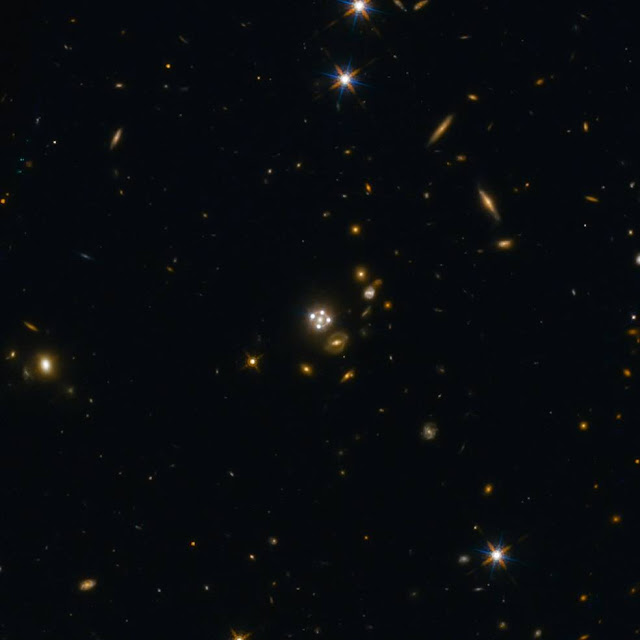Evidence Supporting Accelerated Universe Expansion
by noreply@blogger.com (brian wang) from NextBigFuture.com on (#2BH5E)
The Hubble constant - the rate at which the Universe is expanding - is one of the fundamental quantities describing our Universe. A group of astronomers from the H0LiCOW collaboration, led by Sherry Suyu, Max Planck professor at the Technical University Munich (TUM) and the Max Planck Institute for Astrophysics in Garching, Germany, used the NASA/ESA Hubble Space Telescope and other telescopes in space and on the ground to observe five galaxies in order to arrive at an independent measurement of the Hubble constant.
The new measurement is completely independent of - but in excellent agreement with - other measurements of the Hubble constant in the local Universe that used Cepheid variable stars and supernovae as points of reference
However, the value measured by Suyu and her team, as well as those measured using Cepheids and supernovae, are different from the measurement made by the ESA Planck satellite. But there is an important distinction - Planck measured the Hubble constant for the early Universe by observing the cosmic microwave background.
While the value for the Hubble constant determined by Planck fits with our current understanding of the cosmos, the values obtained by the different groups of astronomers for the local Universe are in disagreement with our accepted theoretical model of the Universe. "The expansion rate of the Universe is now starting to be measured in different ways with such high precision that actual discrepancies may possibly point towards new physics beyond our current knowledge of the Universe," elaborates Suyu.
The targets of the study were massive galaxies positioned between Earth and very distant quasars - incredibly luminous galaxy cores. The light from the more distant quasars is bent around the huge masses of the galaxies as a result of strong gravitational lensing. This creates multiple images of the background quasar, some smeared into extended arcs.
 International astronomers using the NASA/ESA Hubble Space Telescope have made an independent measurement of how fast the Universe is expanding. The newly measured expansion rate for the local Universe is consistent with earlier findings. These are, however, in intriguing disagreement with measurements of the early Universe.
International astronomers using the NASA/ESA Hubble Space Telescope have made an independent measurement of how fast the Universe is expanding. The newly measured expansion rate for the local Universe is consistent with earlier findings. These are, however, in intriguing disagreement with measurements of the early Universe.
Credits: NASA, ESA, Suyu (Max Planck Institute for Astrophysics), Auger (University of Cambridge)
Read more










The new measurement is completely independent of - but in excellent agreement with - other measurements of the Hubble constant in the local Universe that used Cepheid variable stars and supernovae as points of reference
However, the value measured by Suyu and her team, as well as those measured using Cepheids and supernovae, are different from the measurement made by the ESA Planck satellite. But there is an important distinction - Planck measured the Hubble constant for the early Universe by observing the cosmic microwave background.
While the value for the Hubble constant determined by Planck fits with our current understanding of the cosmos, the values obtained by the different groups of astronomers for the local Universe are in disagreement with our accepted theoretical model of the Universe. "The expansion rate of the Universe is now starting to be measured in different ways with such high precision that actual discrepancies may possibly point towards new physics beyond our current knowledge of the Universe," elaborates Suyu.
The targets of the study were massive galaxies positioned between Earth and very distant quasars - incredibly luminous galaxy cores. The light from the more distant quasars is bent around the huge masses of the galaxies as a result of strong gravitational lensing. This creates multiple images of the background quasar, some smeared into extended arcs.
 International astronomers using the NASA/ESA Hubble Space Telescope have made an independent measurement of how fast the Universe is expanding. The newly measured expansion rate for the local Universe is consistent with earlier findings. These are, however, in intriguing disagreement with measurements of the early Universe.
International astronomers using the NASA/ESA Hubble Space Telescope have made an independent measurement of how fast the Universe is expanding. The newly measured expansion rate for the local Universe is consistent with earlier findings. These are, however, in intriguing disagreement with measurements of the early Universe.Credits: NASA, ESA, Suyu (Max Planck Institute for Astrophysics), Auger (University of Cambridge)
Read more